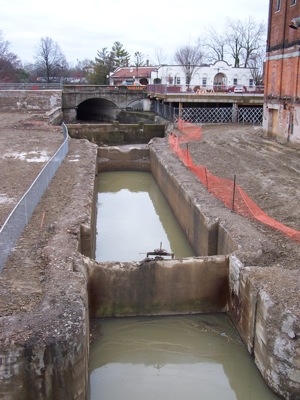Wednesday, December 27th, 2006
Lock 13 secrets uncovered
Structure in St. Marys is unique in the Miami & Erie Canal system
By Janie Southard

Photo by Laura Walker/The Daily Standard
Lock 13 on the Miami & Erie Canal was unearthed this autumn and found to be a rare, customized structure. Side chambers allowed the water to flow through as opposed to the more familiar straight flow of other locks.
ST. MARYS - Uncovering Canal Lock 13 recently in downtown St. Marys answered questions about this unique old lock within the 245-mile Miami & Erie Canal system.
Steve Dorsten, canal operations manager with Ohio Department of Natural Resources, Division of Water, told The Daily Standard this morning the lock had been buried under a section of the former St. Marys Woolen Mill (more recently the Cotton Mill) for more than 60 years.
"Back then (woolen mill officials) simply built over the canal and used the water as a cistern to wash blankets and mix dyes," Dorsten said.
The adjacent Glass Block building was demolished and the site excavated when the city of St. Marys acquired the fire-damaged building, which had been condemned by the state fire marshal. Former owner Kalvin Schanz carried no insurance on the building and said he was not able to restore or rebuild the burned-out structure.
"Reopening Lock 13 during the demolition and excavation was a tremendous feat. You can see where the original structure was timbered and then replaced with concrete," Dorsten said, adding he wasn't tremendously surprised that the old lock is in such good condition because he had been down in the lock's main chamber several years ago.
"The lock was the same width and depth as others, but it wasn't apparent how it worked. No blueprints remain. Even a retired Cotton Mill guy couldn't remember years ago how the water flowed through," he said.
After the lock was uncovered, it was apparent the structure had been customized with side chambers that allowed the water to flow through.
Dorsten's department runs into canal structures all the time that he classifies as having no "rhyme or reason." Repairing canal banks over the years has turned up wooden timbers of old structures whose original purpose is now anyone's guess.
He explained that as long as wood is not exposed to oxygen those old canal timbers are rock hard. But once the air hits, they are immediately affected.
An interesting and recognizable structure also uncovered during the excavation of the Glass Block and Woolen Mill section was the top of a large stone archway on the backside of the Glass Block opening toward the lock.
"We figure canal boats probably docked there to take on goods. It makes sense, but we really can't prove it. Basically it's still buried, but there are old photos of it," he said, noting that would be one direct connection between the canal and the Glass Block. But there is no evidence water from the canal was used in any way in the building.
Dorsten commented everyone's been in the dark for at least 40 years about this old lock.
"We're getting a lot of our questions answered. We now know this lock was very unique," he said.
As to the future, the city, state and local partners are considering working together to keep the corridor open between the canal pathway to the north of High Street and ultimately running it along Lock 13 under Spring Street to Memorial Park.
